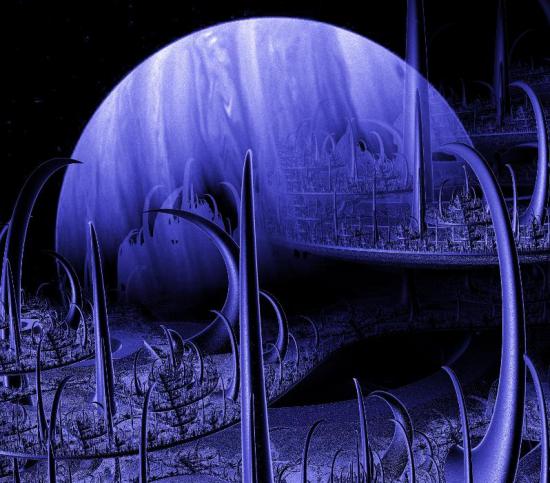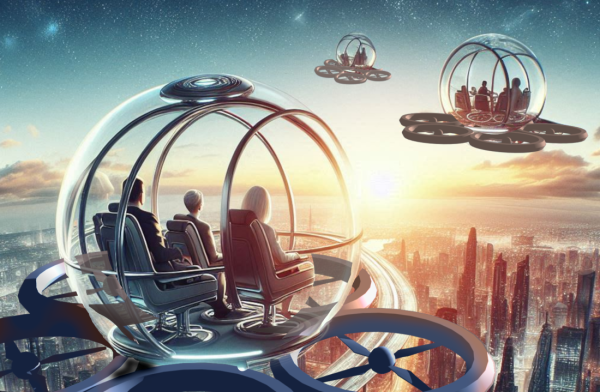BY LETTER
Polymorphic Architecture
Culture and Society > Fine Arts > Architecture
Technology > Application > Construction
Technology > Application > Envirotech
Technology > Application > Infrastructure
Technology > Application > Construction
Technology > Application > Envirotech
Technology > Application > Infrastructure
 Image from Steve Bowers |
Polymorphic Architecture and Infrastructure
Throughout the Interplanetary Age advances in smart materials and programmable matter allowed the production of morphable products and environments. This movement started with simple household items that could change their characteristics (such as colouring and size) on demand. As these technologies developed it became popular for high-classed hotels and resorts to offer fully programmable rooms that would alter their characteristics to suit their client's needs and mood. This in turn led to the development of environmental optimization protocols that autonomously adjust a sophont's local environment for maximum comfort and enjoyment.Technologies continued to improve allowing more and more architecture and infrastructure to be converted to morphable technology to the point where just prior to the Technocalypse it was rare to find any sophont whose environment was not programmable in some manner. This proved to be highly dangerous in the Technocalypse as rampant malware caused dangerous and potential fatal changes in polymorphic environments; some notable examples were large tower blocks assuming fractal shapes (squeezing their contents and inhabitants into ever small spaces), household appliances morphing into lethal weapons and programmable walls fusing all doors and windows closed.
It wasn't until various megacorps in the Middle Federation age picked up the ancient ideas and improved them with modern technology (utility fog, expert-antivirus, blue goo etc) that fully polymorphic architecture and infrastructure became available (this movement was the precursor for the first anglenets and correspondingly the first demonnets).
After its maturation it became commonplace for homes, buildings and even entire cities in some cultures to be constructed out of polymorphic programmable material. The type of material used greatly varies depending on the required task but generally materials possess the ability to change multiple characteristics such as: colour, texture, shape, size, conductivity (electrical and thermal), temperature and albedo. Depending on the technology level/cultural choice of the society in question polymorphic architecture and infrastructure can manifest with in situ nanocells, forge integrated technology (for materials that cannot rearrange, move, replicate, modify etc themselves) or a combination of both. Due to the diversity both in capability and practice the morphing/construction times of polymorphic materials varies greatly; depending on the size, intended function, and planned durability of a structure (as well as the technology being used), construction can take anywhere from seconds to days.
In some societies this has lead to some interesting changes in urban environments compared to previous ages. The biggest of these is the abolishment of rooms and buildings built for individual functions. Throughout urban history sophonts have built rooms with functions in mind; rooms for sleeping, rooms for bathing, rooms for food preparation, rooms for eating, rooms for relaxation, rooms for formal events, rooms for sanitation and the list goes on and on. Cities were also planned this way with buildings and even entire districts being built with specific functions in mind be they residential, commercial, industrial etc. In some polymorphic environments this approach has either partially or completely disappeared, individual homes can now be morphable outer shells whose interior can change as desired. At night the whole home can reconfigure for relaxation and sleeping, by day for recreation, work and entertainment.
Walls and divisions can be thrown up at will, household appliances can be formed from utility fog where possible or where required assembled/extruded from hidden compartments. In many societies the polymorphic approach has changed urban settlements just as drastically, now everyday a sophont can wake up to see different structures outside their home. Recreational facilities can pop up as desired, public areas can change around individual sophonts to suit their tastes and entire cities can change appearance in short order. In some societies words like "restaurant", "office" and "shop" have faded from use as the faculties of these things (and more) have became decoupled from geography and instead can be conjured from the environment at any time.
Sophisticated polymorphic infrastructure even allows a merging of the physical and virtual. With programmable surfaces, utility fog and other augmented reality media virch inhabitants can walk into the physical world in a utility fog body with the ease that sophonts from previous ages walked between rooms. Correspondingly real world inhabitants are expressed in the virch as data entities. Worlds such as Nathan and Fata Morgana are particularly renowned for merging the virtual environment with real life.
Travel Pod
 Image from Steve Bowers and Bing Image Creator |
One last important point to note about the effect of polymorphic architecture and infrastructure on cultural behaviours is a tendency for digital nomadism to arise in some or all of the population at some time in their lives. Since the majority of personal effects can be either morphed from the environment or quickly assembled in autofabs rather than having set locations for their homes some sophont's simply take the digital template for their home and travel continuously. Whenever they desire their own home (perhaps to eat or sleep) they simply find appropriate empty space and upload their home template into the local programmable matter and in short order their home is available.
There are societies where this habit is taken to the extreme and frequently entire neighbourhoods, cities and habs can change location on a whim, even relocating to polymorphic infrastructure in other star systems! Suffice to say cartography in such societies is a complex field.
Related Articles
- Environmental Engineering - Text by M. Alan Kazlev, from the original by Robert J. Hall
Ensuring environments remain favourable to bionts. Includes both environmental protection (pollution control, waste recycling or treatment) and habitat biosphere optimization, biont hygiene and health issues and standards, and biosphere engineering in general (biospherics). - Environmental Optimization Protocols
- Materials Science - Text by M. Alan Kazlev
The study and application of the nature and properties of various materials, including alloys, ceramics, composites, gels, membranes, polymers, synthetics, and biological materials, as well as completely neohylogenic nano materials, on the macro, micro, nano, and pico scale. - Personal Transport Technology
- Programmable Matter, Smart Matter
Appears in Topics
Development Notes
Text by Ryan B (Rynn)
Initially published on 12 March 2012.
Initially published on 12 March 2012.






